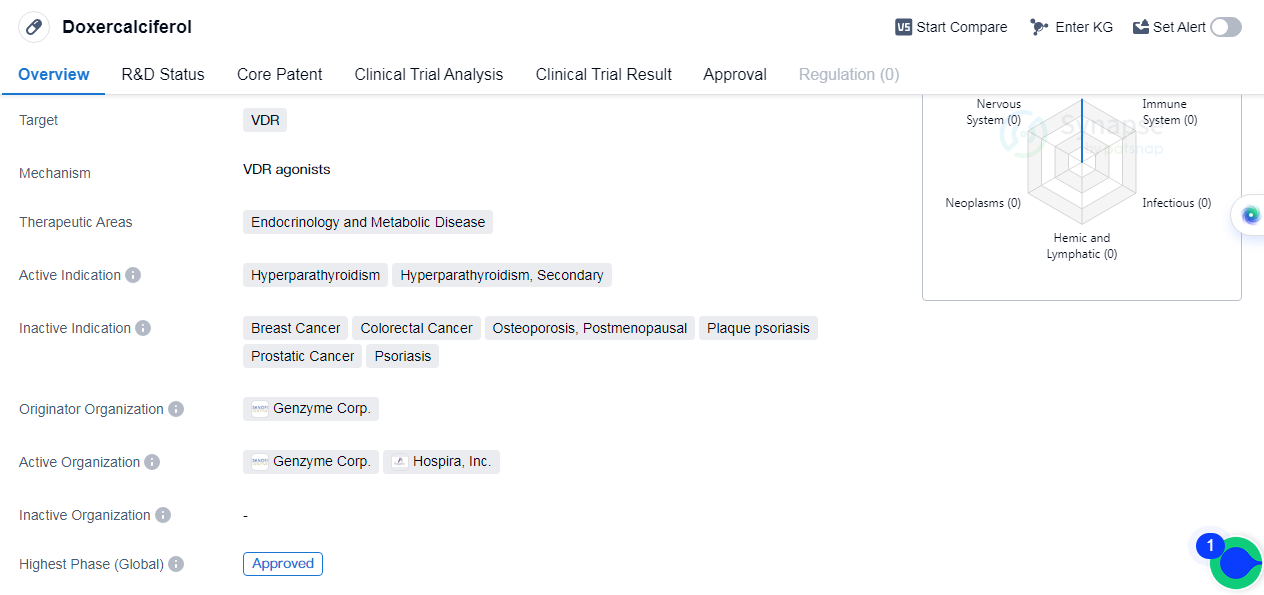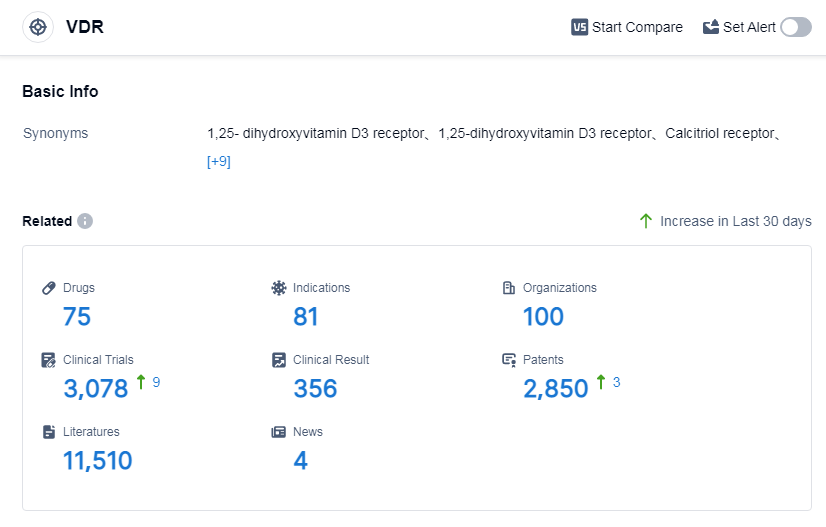Doxercalciferol Unveiled: A Detailed Overview of its Revolutionary R&D Breakthroughs, Mechanisms of Action, and Drug Target
Doxercalciferol's R&D Progress
Doxercalciferol is a small molecule drug that falls under the therapeutic areas of endocrinology and metabolic disease. It specifically targets the vitamin D receptor (VDR). The drug is primarily indicated for the treatment of primary and secondary hyperparathyroidism.
The originator organization of Doxercalciferol is Genzyme Corp., a renowned pharmaceutical company. The drug has reached the highest phase of development, which is approval. It received its first approval in the United States in June 1999.
Hyperparathyroidism is a condition characterized by the overactivity of the parathyroid glands, leading to excessive production of parathyroid hormone (PTH). This can result in elevated levels of calcium in the blood, leading to various complications. Doxercalciferol is used to manage hyperparathyroidism by regulating the levels of PTH and calcium.
The drug acts by binding to the vitamin D receptor, which is present in various tissues throughout the body. Activation of the VDR by Doxercalciferol helps in the regulation of calcium and phosphate metabolism. By modulating the VDR, the drug can effectively control the overproduction of PTH and normalize calcium levels.
Doxercalciferol has been approved for use in the United States since 1999, indicating its established safety and efficacy profile. It has been widely prescribed by healthcare professionals for the treatment of primary and secondary hyperparathyroidism.
👇Please click on the image below to directly access the latest data (R&D Status | Core Patent | Clinical Trial | Approval status in Global countries) of this drug.
Mechanism of Action for Doxercalciferol: VDR agonists
VDR agonists are a type of drug that activate the vitamin D receptor (VDR) in the body. The VDR is a nuclear receptor that plays a crucial role in regulating the expression of genes involved in various physiological processes, including calcium and phosphate homeostasis, immune function, and cell growth and differentiation.
From a biomedical perspective, VDR agonists are used in the treatment of osteoporosis, psoriasis, and autoimmune diseases. By activating the VDR, these agonists mimic the effects of natural vitamin D and help regulate the expression of target genes, thereby promoting bone health, modulating immune responses, and exerting other therapeutic effects.
VDR agonists can be synthetic compounds specifically designed to activate the VDR or natural compounds derived from sources like plants or animals. Examples of VDR agonists include calcitriol, paricalcitol, and doxercalciferol. These drugs are typically administered orally or through injections, and their dosage and duration of treatment depend on the specific condition being addressed.
It is important to note that the use of VDR agonists should be carefully monitored and prescribed by healthcare professionals, as they can have potential side effects and interactions with other medications. Regular monitoring of calcium and vitamin D levels is often necessary during treatment with VDR agonists to ensure optimal therapeutic outcomes and minimize adverse effects.
Drug Target R&D Trends for Doxercalciferol
According to Patsnap Synapse, as of 6 Sep 2023, there are a total of 75 VDR drugs worldwide, from 100 organizations, covering 81 indications, and conducting 3078 clinical trials.
The analysis of the target VDR reveals a competitive landscape with several companies actively involved in research and development. Roche Holding AG, LEO Fondet, LEO Pharma A/S, OPKO Health, Inc., and Maruho Co., Ltd. are the companies growing fastest under the target VDR. These companies have made significant progress in advancing drugs through different stages of development. Indications such as secondary hyperparathyroidism, osteoporosis, psoriasis, and vitamin D deficiency have seen the highest number of approved drugs. Small molecule drugs and cell therapy are the drug types progressing most rapidly, with small molecule drugs having the highest number of approved drugs. China, the United States, Japan, the European Union, and Canada are the countries/locations developing fastest under the target VDR, with China showing notable progress. Overall, the target VDR presents a competitive landscape with opportunities for further development and innovation in the pharmaceutical industry.
👇Please click on the picture link below for free registration or log in directly if you have a freemium account, you can browse the latest research progress on drugs, indications, organizations, clinical trials, clinical results, and drug patents related to this target
Conclusion
In summary, Doxercalciferol is a small molecule drug developed by Genzyme Corp. It targets the vitamin D receptor and is primarily used for the treatment of hyperparathyroidism. The drug has received approval in the United States and has been available since 1999. Its mechanism of action involves regulating calcium and phosphate metabolism by modulating the VDR.






